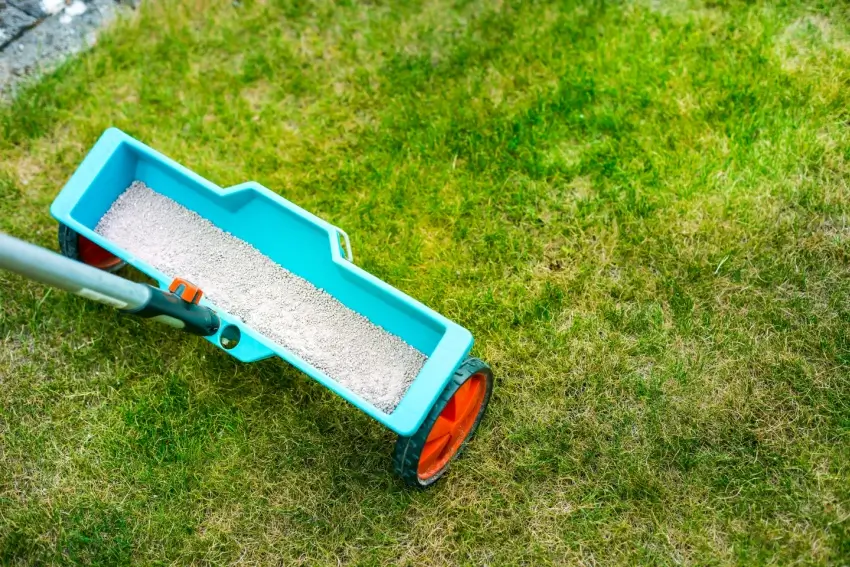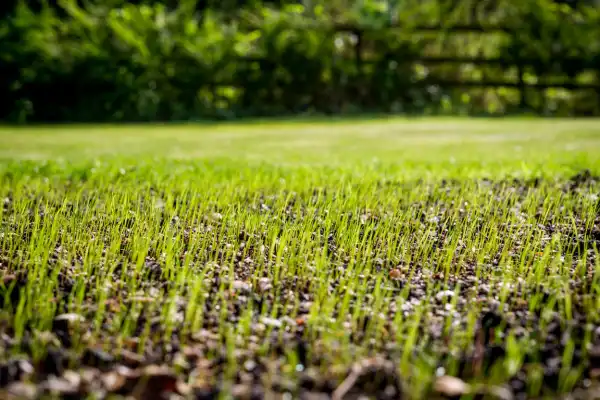New Grass Fertilizer: Tips for Applying New Lawn Fertilizer

Whether you plan to seed a new lawn, lay down some sod, or overseed your existing lawn, give your new grass every chance to grow strong and healthy. Lawn fertilizer can play a big role in your efforts by providing the essential nutrients your new seeds require to establish a strong root system and thrive. What type of new grass fertilizer should you use, and how should you apply it to ensure you’ll soon enjoy a vibrant, lush lawn? Our expert advice on new lawn fertilizer will set you up for success.
Table of Contents:
Choosing the Right Fertilizer for New Grass
Every lawn is different, and the best thing you can do to choose the right fertilizer for your new grass seed is to perform a soil test. You can find DIY soil tests at most garden and lawn stores to help you understand which nutrients you need to add and at what concentrations to your soil.
Most homeowners will be best served by using a starter fertilizer for new grass. All fertilizers contain a ratio of nitrogen, phosphorus, and potassium (known as NPK) along with micronutrients. Starter fertilizer typically contains higher-than-average amounts of phosphorus, which assists in root development. Look for fertilizer with an NPK ratio where the middle number, the phosphorus, is the highest.
When to Fertilize a New Lawn
If you are planting cool-season grass, like Kentucky bluegrass or fescues, you’ll want to seed and fertilize in the fall. That switches to spring or early summer if you live in a warmer area of the country and plan to seed with a warm-season grass, like Bermuda or Zoysia.
When it comes to adding fertilizer, you can either fertilize before or after planting new grass seed. Our recommendation is to add fertilizer for new grass before seeding, as this ensures the nutrients from the fertilizer are readily available to the seeds and lowers the risk of fertilizer burn.
If you are putting down sod, fertilize your soil first.
Application Techniques for Fertilizing New Grass

Ready to use your new grass fertilizer? First, prep your lawn by removing any debris, like leaves, rocks, and dead branches. Next, use a rake or rototiller to loosen the top layer of soil. If you plan to apply your fertilizer first, now is the time.
Most fertilizers come as granules or liquids. If using granules, spread them evenly across your lawn using a drop-type spreader, a broadcast spreader, or your hands (just make sure to wear gloves!). Use a sprayer hooked up to your hose if you have liquid fertilizer. Either way, take the time to cover the entire lawn in overlapping stripes. A good rule of thumb is to apply 0.5 to 1 pound of nitrogen per 1,000 square feet of lawn. We recommend fertilizing when temperatures are cool in the early morning or late evening.
Once you’ve spread the fertilizer, lightly rake it into the top few inches of soil. Don’t mix too deep. You want your grass seed to access as much of the nutrients as possible.
Next, evenly apply your grass seed and rake the seeds into the top layer of the soil. Again, you can also choose to add fertilizer for new grass after seeding.
Will Fertilizer Kill New Grass?
If you carefully follow the instructions on your fertilizer product and apply it correctly, you shouldn’t have any issues with the fertilizer harming your grass. However, adding too much fertilizer can cause “fertilizer burn,” leading to avoidable brown patches, stunted growth, or even lawn death.
Managing Your Newly Fertilized Lawn

Adding seeds and new grass fertilizer to your yard is just the start of your new and improved lawn. You’ll want to thoroughly water your lawn immediately after adding the fertilizer and seeds. It’s important to keep the soil moist (but not soaked) until your grass seeds begin to germinate (or sprout). Water twice a day for the first week, then gradually reduce your watering to once or twice a week in the early morning. Establish a watering schedule based on your climate zone.
Keep the pets, kiddos, and other family members off the lawn until the grass is well-established, usually six to eight weeks after germination. At this time, you can switch over to a regular fertilization schedule. We recommend fertilizing every other month during the growing season, though it’s a good idea to seek an expert opinion on the right fertilization schedule for your lawn.
Avoid Common Fertilizer Mistakes By Hiring Lawn Care Experts
It can be surprisingly easy to accidentally over fertilize your lawn or to choose the wrong fertilizer for the needs of your soil. If you’re going through all the expense and effort of starting a new lawn (or overseeding a struggling lawn), it could make sense to use an expert lawn care team.
That’s what you’ll get when you contact us at The Grounds Guys®. Our local teams can test your soil and apply the best new lawn fertilizer to your grass. In fact, we can handle every step of establishing your new lawn, whether you want to begin with seeds or install sod. We offer knowledge, expertise, a friendly attitude, and excellent customer service. That’s our Neighborly Done Right Promise™ to you.
Ready to get the best lawn on the block? Ready to get started? Contact your local The Grounds Guys team and request a free estimate.
 Click to call
Click to call


